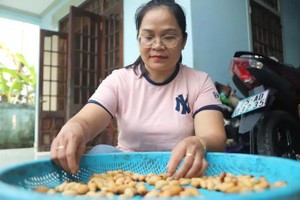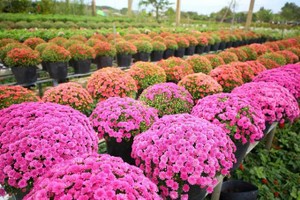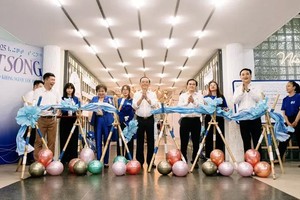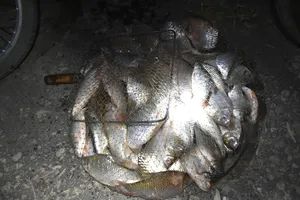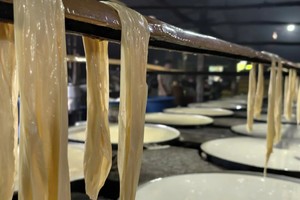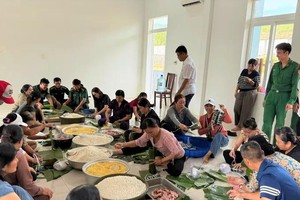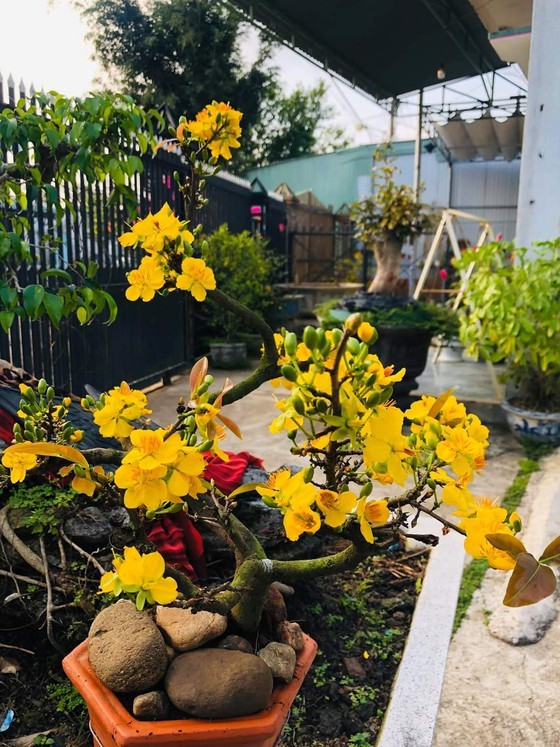 A yellow apricot tree at a house in the village (Photo: SGGP)
A yellow apricot tree at a house in the village (Photo: SGGP)
The Dong Thap Muoi area in the northwest of Long An province was still a ‘wild field’ flooded with flood water for four months a year more than 30 years ago.
The province’s authorities launched the program ‘reclaiming Dong Thap Muoi’ with a lot of efforts to release alum, wash salt, improve the soil to transform a desolate lowland with few people into fertile land with canvas, thousands of melaleuca forests interwoven with green rice fields and yam fields.
Moreover, in recent years, Tan Tay plum village, an interesting highlight of the region along National Highway 62, is a location people usually talk about.
Although the Tet holidays ( the Lunar New Year) have passed, the field in the village is covered with the yellow color of the apricot flower. Traders from other Mekong Delta provinces and the Central region still flock to the village to buy the trees.
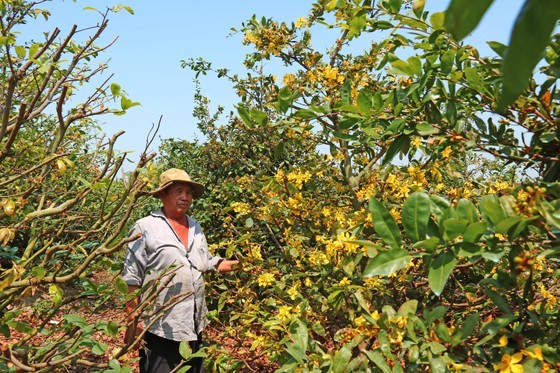 A farmer in his yellow apricot field (Photo: SGGP)
A farmer in his yellow apricot field (Photo: SGGP)
Traders from Tien Giang Province were offering to buy 200 five-year-old apricot trees at farmer Nguyen Van Hoang’s field at VND 3 million- VND5 million each. Mr. Hoang still takes care of more than 2,000 small apricot trees; therefore, he agreed to sell 200 trees.
He revealed he has grown additional 200 trees for five years and 1,000 other flower trees. In the village, it comes as no surprise that many people can earn hundreds of millions or billions from selling a yellow apricot tree because the trees are grown in the village are preferred by bonsai connoisseurs.
Standing in the middle of the yellow apricot forest with gentle winds under the sunshine of the coastal country, Nguyen Cuong, an agricultural officer of Tan Tay commune, pointed to a white tomb saying that it is the resting place of Mr. Tran Van Thong, born in 1981, who had the merit of bringing apricot farming to this alkaline land.
People secretly honored him as the ‘ancestor of apricot craft’ in this village because in the village he was the pioneer in growing and trading apricots, changing the life of his family and the whole region.
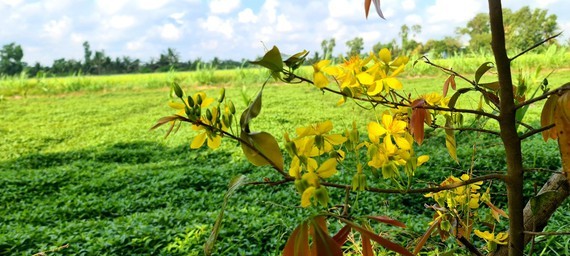 A corner of the village (Photo: SGGP)
A corner of the village (Photo: SGGP)
In 2003, the young man in the village went to Ben Tre Province to learn from experience in growing apricots, then returning home, he started to plant 500 apricot trees. After nearly five years, he sold his apricot garden for nearly VND500 million, then continued to buy more land and improve it to continue growing apricots.
Following Mr. Thong, the villagers converted rice fields into apricot cultivation fields. Mr. Thong then, unfortunately, had a serious illness and died. Thong's grave is located in the middle of thousands of apricot gardens, as if to commemorate the efforts of the young man who contributed to the development of the apricot village, leaving a good name and reaching as far as it is today.
Thong passed away, his family continued to promote his apricot growing career and was in one of the wealthiest households in the village. In front of his house is a nearly 20-year-old apricot tree planted by himself from the beginning, although many people pay billions of dollars, his family still does not sell.
 A farmer is taking care of the yellow apricot trees each worth VND50 million (Photo: SGGP)
A farmer is taking care of the yellow apricot trees each worth VND50 million (Photo: SGGP)
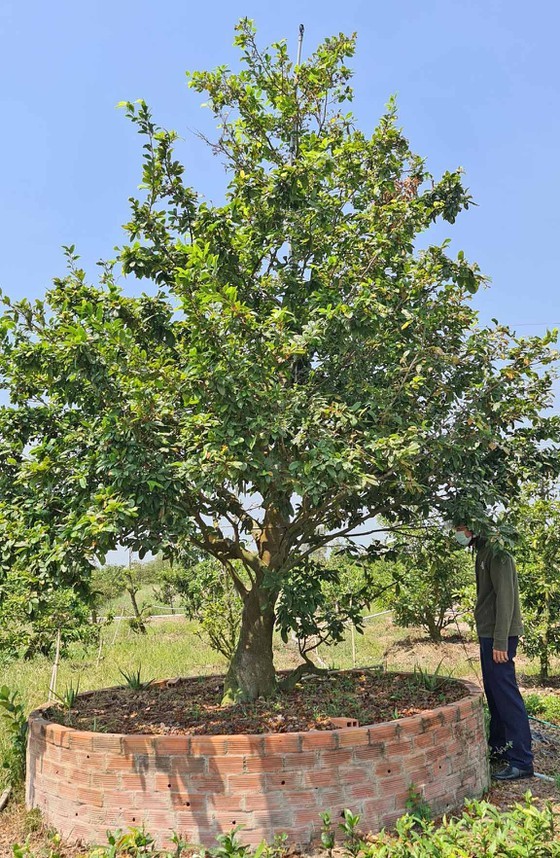 A big apricot tree in the village (Photo: SGGP)
A big apricot tree in the village (Photo: SGGP)
A 72-year-old Pham Van Tu took us to visit his apricot garden saying that in the past, his family lived on growing rice two crops a year, which was enough to eat.
After residents in the village have been successful in growing apricots, Tu also tried to grow yeast along the banks and in the garden on about 1 hectare of land. Later, he netted much so he decided to nurse young apricot trees for planting, so far it has been 10 years with nearly 4 hectares and thousands of apricot trees of all ages.
Last year, despite the epidemic, he also sold 20 nine-year-old apricot trees at the price of VND50 million each in addition to 2-year-old and 3-year-old roots with beautiful flowers for people to play Tet. His life is better thanks to the apricot tree.
Thanks to perseverance in learning, clinging to the village, Tan Tay Village is now famous all over the country for its primitive apricots with big roots.
Villagers have poured more money into the cultivation of the tree. The policy bank of the commune has also spent a large amount of capital to let people convert crops to growing apricots. The commune's yellow apricot branch as well as the people are ready to guide and share experiences for people in the village to grow apricots.
In the past time, Thanh Hoa district has also paid attention to infrastructure investment, promoted the transfer of science and technology, and provided vocational training for the development of yellow apricot cultivation in Tan Tay and achieved economic efficiency.
Mr. Nguyen Van Hoang, a local man, said that he is going to build a house to welcome visitors who will spend days in the village. People know how to make apricot trees bloom all year round, so visitors can see yellow apricot blossoms in the garden, plus available local products. He supposed the village will be an attraction for tourists in this Dong Thap Muoi area.
 A house in the village (Photo: SGGP)
A house in the village (Photo: SGGP)
According to Mr. Nguyen Van Chan, Chairman of Tan Tay Commune People's Committee, currently, the total area of apricot growing in the commune is more than 340 hectares, mainly concentrated along the Vam Co Tay River.
In the coming time, the local administrations and related agencies will develop this place into a tourism destination. The goal in 2022 is to strive to turn the Tan Tay commune into a new and improved rural commune. The Tan Tay plum village was officially recognized by the People's Committee of Long An Province in July 2020.
Recently, the Center for Rural Development - Saemaul Undong of University of Social Sciences and Humanities under Vietnam National University Ho Chi Minh City had a working session with the functional sectors of Long An province on the unification of building a project on developing apricot-growing craft villages in Tan Tay commune, associated with tourism development in Long An Province to 2030.
Development of this craft village in association with eco-tourism not only improves economic efficiency but also be a highlight in the image of the Dong Thap Muoi region, said Ms. Dinh Thi Phuong Khanh, Deputy Director of the Department of Agriculture and Rural Development of Long An province.
In Dong Thap Muoi today, from the success in Tan Tay commune, yellow apricot cultivation has developed to Tan Dong, Thuy Dong, Thuy Tay communes in Thanh Hoa District and Long Thanh and Tan Thanh communes in Thu Thua District to turn the ‘wild field’ into the ‘Kingdom of plum blossom’ in the future.
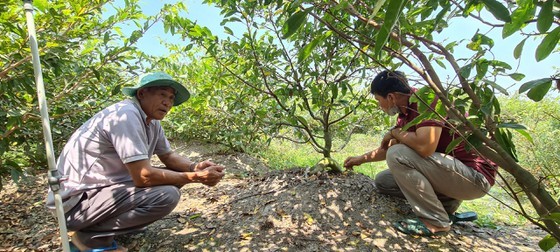 Traders are proposing to buy plum apricot trees (Photo: SGGP)
Traders are proposing to buy plum apricot trees (Photo: SGGP)
